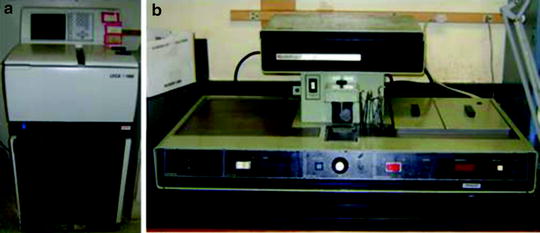Fig. 1.
Depicts (a) rodent brain matrix, (b) a basket along with a cassette (arrow) in to which tissue is placed following fixation and trimming of tissue to required size, and (c) following placement of the tissue in to a cassette, it is arranged as shown by an arrow. This basket containing approximately 40 cassettes is placed in a tissue processor.
Some laboratories do not carry out perfusion–fixation; rather they remove and leave the whole brain in buffered FAM (formalin, acetic acid, and methanol) for 24 h followed by cutting into four pieces and fixation for an additional 24 h at 4°C.
3.2 Tissue Processing for Embedding
The purpose of tissue processing is to embed the tissue in a solid medium to give tissue enough rigidity to enable thin sections to be cut. For histology, paraffin wax is routinely used as an embedding material. Tissue processing can be done either manually, or by using an automated tissue processor. To use an automated tissue processor, a fixed piece of tissue is placed in a plastic cassette (Fig. 1b) and dip it into a large beaker/jar under running tap water. Tissue is normally washed for approximately 1 h to remove the excessive fixative. This will be followed by washing the tissue-containing cassettes in a basket (Fig. 1b, c) provided with the tissue processor and placing a basket containing tissue cassettes in the automated tissue processor (Fig. 2). Tissue automated processing is done in the following steps (4).


Fig. 2.
Depicts (a) a tissue processor and (b) an embedding center.
1.
Dehydration: During this step, fixative and water are replaced by dehydrating fluids. Routinely used dehydrating fluids include ethanol, methanol, isopropyl alcohol, and acetone. To process brain for histology, ethanol is routinely used by various laboratories. Tissue must undergo a descending dehydration, i.e., successive immersion in 70, 95, and 100% ethanol.
2.
Clearing: During this step, the dehydrating agent from the tissue is replaced by clearing agent. Fluids which are miscible with both dehydrating agents and paraffin wax are generally hydrocarbon solvents (with refractive index similar to protein) such as xylene, toluene, chloroform, or citrus fruit oils (commonly used now owing to its non-toxic nature). When tissue processing is carried out manually, one can observe that tissue appears translucent once the dehydrating agent is completely replaced by clearing agent.
3.
Impregnation: During this step, the clearing agent is replaced by an embedding medium; i.e., paraffin wax. In an automated tissue processor, tissue is processed until this step. Usually for tissues like brain, an overnight (Table 1) program in the automated tissue processor is used. At the end of a paraffin wax cycle, the basket containing tissue cassettes is taken out and individual cassettes are immersed in melted wax chamber of an embedding center (Fig. 3).
Table 1
Brain tissue processing schedule for an automated tissue processor
Container | Fluid | Time (min) |
|---|---|---|
1 | 70% alcohol | 30 |
2 | 95% alcohol | 30 |
3 | 100% alcohol | 30 |
4 | 100% alcohol | 60 |
5 | 100% alcohol | 60 |
6 | 100% alcohol | 60 |
7 | 100% alcohol/xylene < div class='tao-gold-member'>
Only gold members can continue reading. Log In or Register to continue
Stay updated, free articles. Join our Telegram channel
Full access? Get Clinical Tree
 Get Clinical Tree app for offline access
Get Clinical Tree app for offline access

|